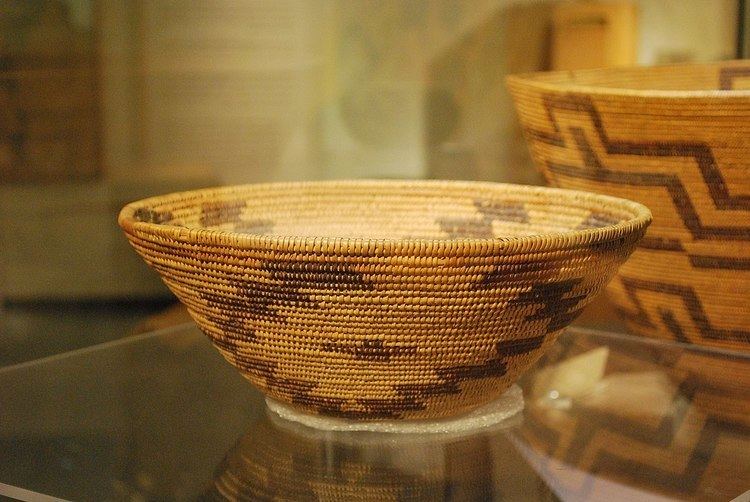 | ||
The Maidu are an tribal people of northern California. They reside in the central Sierra Nevada, in the drainage area of the Feather and American Rivers. They also reside in Humbug Valley. In Maiduan languages, Maidu means "man".
Contents
Local divisions
There are three subcategories of Maidu:
Population
Estimates for the pre-contact populations of most native groups in California have varied substantially. Alfred L. Kroeber estimated the 1770 population of the Maidu (including the Konkow and Nisenan) as 9,000. Sherburne F. Cook raised this figure slightly, to 9,500.
Kroeber reported the population of the Maidu in 1910 as 1,100. The 1930 census counted only 93. As of 1995, the Maidu population had recovered to an estimated 3,500.
Culture
The Maidu were hunters and gatherers.
The Maidu were exemplary basket weavers, weaving highly detailed and useful baskets in sizes ranging from thimble-sized to huge ones ten or more feet in diameter. The stitches on some of these baskets are so fine that you need a magnifying glass to see them. In addition to closely woven, watertight baskets for cooking, they made large storage baskets, bowls, shallow trays, traps, cradles, hats and seed beaters. To make these baskets, they used dozens of different kinds of wild plant stems, barks, roots and leaves. Some of the more common were fern roots, red bark of the redbud, white willow twigs and tule roots, hazel twigs, yucca leaves, brown marsh grass roots and sedge roots. By combining these different kinds of plants, they were able to make geometric designs on their baskets in red, black, white, brown or tan.
Subsistence
Like many other California tribes, the Maidu were hunters and gatherers and did not farm. They practiced grooming of their gathering grounds, with fire as a primary tool for this purpose, and tended local groves of oak trees to maximize production of acorns, which were their principal dietary staple. The abundance of acorns made it possible for the Maidu to store large quantities for harder times, and they used their basket-making skills to construct above-ground acorn granaries.
Besides acorns, which provided dietary starch and fat, the Maidu lived in an environment rich in plant and animal life, much of it edible, and they supplemented their acorn diet with edible roots (for which they were nicknamed "Digger Indians" by European immigrants), fish from the many streams and rivers, and other plant and animal species. The seeds from the many flowering plants as well as the corms from many wild flowers provided much of the sustenance to the People of the area. Wildlife of every sort was also utilized within a spiritual reference. Deer, elk, antelope as well as all the multitude of smaller game were utilized on a regular basis. Fish were a prime source of protein, starting with the multi run salmon, then relying on the local indigenous fishes that supplied food the year round.
Housing
Maidu housing, especially higher in the hills and the mountains, was largely semi-underground. These houses were sizable, circular structures twelve to 18 feet in diameter, whose floors were as much as three feet below ground level. Once the floor of the house was dug, a pole framework was built, then a covering of pine bark slabs upon which a heavy layer of earth was placed along the base of the structure. With a central fire in the house at ground level, a stone-lined pit and bedrock mortar to process foods, meals were always ready to feed the family. For summer dwelling, a different structure was built from cut branches tied together and fastened to sapling posts, then covered with brush and dirt. The summer shelters were built with the principal opening facing east to catch the rising sun, and to escape the heat of the afternoon.
Social organization
They lived in small villages or tribelets with no centralized political organization. Leaders were typically selected from the pool of men who headed the local Kuksu cult, but generally did not exercise day-to-day authority, being primarily responsible for settling internal disputes, and negotiating over matters arising between villages.
Religion
The primary religious tradition of the Maidu revolved around the Kuksu cult, which was a central California religious cult system based on a male secret society and characterized by the Kuksu or "big head" dances. Besides the Maidu, this cult system was also followed by the Pomo and the Patwin among the Wintun and later were forced by the missionaries to change their religion.
Languages
The Maidu spoke a language held by some authorities to be of the Penutian linguistic stock. While all Maidu spoke a form of this language, the grammar, syntax and vocabulary differed sufficiently that Maidu separated by large distances or by geographic features that discouraged travel might actually speak nearly mutually unintelligible dialects of the tongue.
There were four principal divisions of the language: Northeastern Maidu, Yamonee Maidu (known simply as Maidu); Southern Maidu or Nisenan; Northwestern Maidu or Konkow; and Valley Maidu or Chico.
Rock art
The Maidu inhabited areas in northeastern Sierra Nevada. This area and the sites they occupied contain many examples of rock art and petroglyphs. There is some confusion on whether this rock art and other site remains are from previous populations of peoples or from the Maidu people themselves. Regardless, the Maidu people incorporated these works into their cultural system, due to their beliefs that artifacts are real, living energies that are an integral part of their world.
Federally recognized
Non-federally recognized
Contemporary artists
Ninsenan Indian tribe
Traditional narratives
Stories of K'odojapem/World-maker and Wepam/Trickster Coyote are particularly prominent in Maidu traditional narratives.
